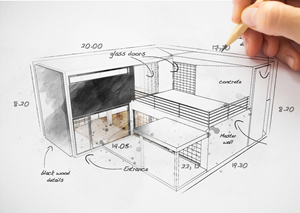Texas HOA Architectural Committee Guidelines + the Ultimate Review Checklist
Whether you call it an Architectural Control Committee (ACC), Architectural Review Committee (ARC), Landscape Review Committee, or HOA Architectural Review Board, most Texas homeowners associations (HOAs) have some form of an Architectural Committee. Texas HOA architectural committee guidelines grant members of this committee oversight of any changes made to a property or common area, making sure the changes are in line with the Covenants, Conditions, and Restrictions (a.k.a. CC&Rs) established by the association.
Why is an HOA Architectural Committee so important? This committee plays a critical role in regulating how homes look, as aesthetics and curb appeal significantly affect property values. Since this committee is such a staple in Texas associations, let’s explore more about Texas HOA architectural committee guidelines, members’ responsibilities, committee powers, who serves on an ACC/ARC, and everything that should be on your Texas HOA Architectural Review Checklist.

Recommending actions to the board: Since the HOA board has the final say, after reviewing each architectural request, the ACC/ARC provides recommendations to the board for approval or rejection.
Monitoring violations: ACC or ARC members keep a close eye out for any architectural violations that are inconsistent with the association's architectural guidelines.
Enforcing the Texas HOA architectural committee guidelines: Ensuring compliance with the rules is essential for maintaining the community's uniformity, appeal, and enhancing property values.
Assessing current standards: ACC/ARC members constantly evaluate the existing standards and make suggestions for changes to the HOA board if necessary.
The committee’s architectural review process also depends on the type of community association. For example, in condo owners associations (COAs), exterior architectural alterations are a no-go. In this case, the ACC/ARC will focus on interior modifications (think: plumbing and electrical systems), as well as exterior additions like EV charging stations, solar panel installations, etc.

The key to an effective ACC or ARC is having members who are dedicated – they should have in-depth knowledge of your association’s architectural guidelines and processes and have a shared goal of continuous growth. Members should also proactively seek ongoing education in Texas HOA architectural committee guidelines and processes.
Most of all, committee members should have a passion for service – those who have a genuine desire to act in the best interest of their fellow homeowners, not those who are looking to have their own requests approved. The committee was created to benefit the entire community, after all.
Learn more here about how to successfully create committees that get great volunteers.

No matter your community's architectural guidelines, the most important thing is they should never conflict with federal, state, or local laws. If there are any inconsistencies, the law always takes precedence. As a Texas HOA board member, it’s crucial to stay on top of these laws to avoid breaching homeowners' rights and facing potential liability. A few laws to look out for include: Fair Housing Act, Over-the-Air Reception Devices Rule, and Solar Access Rights.
A seasoned management company can help with the heavy lifting of sorting through your CC&Rs and ensuring compliance with Texas laws. You can also seek counsel from your POA attorney to make sure you have a solid set of Texas HOA architectural committee guidelines for members.
Your Texas HOA architectural committee is an asset to your association’s board. Its members refine the ACC/ARC request process with the shared goal of preserving the aesthetic and enhancing property values within your community. As a Texas HOA board member, establishing an effective ACC/ARC (consistent with the checklist above), and understanding the responsibilities of this committee, is paramount in ensuring the longevity and prosperity of your association.
If your association is not currently managed by FirstService Residential Texas, we would love to learn more about your community. Just click Contact Us below. We look forward to meeting you!
Why is an HOA Architectural Committee so important? This committee plays a critical role in regulating how homes look, as aesthetics and curb appeal significantly affect property values. Since this committee is such a staple in Texas associations, let’s explore more about Texas HOA architectural committee guidelines, members’ responsibilities, committee powers, who serves on an ACC/ARC, and everything that should be on your Texas HOA Architectural Review Checklist.

HOA architectural review committee responsibilities in Texas.
Reviewing applications: Before a homeowner can start any major home improvement project, construct any architectural additions, or make any alterations, he/she must submit a formal request to the HOA architectural committee. Members will carefully review the request to ensure changes comply with the association's architectural standards.Recommending actions to the board: Since the HOA board has the final say, after reviewing each architectural request, the ACC/ARC provides recommendations to the board for approval or rejection.
Monitoring violations: ACC or ARC members keep a close eye out for any architectural violations that are inconsistent with the association's architectural guidelines.
Enforcing the Texas HOA architectural committee guidelines: Ensuring compliance with the rules is essential for maintaining the community's uniformity, appeal, and enhancing property values.
Assessing current standards: ACC/ARC members constantly evaluate the existing standards and make suggestions for changes to the HOA board if necessary.
What powers does an HOA architectural committee have?
Your ACC or ARC’s authority—the do's and don'ts—is outlined in your association’s governing documents. Some HOAs have ARCs that actually make the final architectural decisions, while others reserve that power solely for the HOA board. If it’s ultimately the board’s call, the HOA architectural review committee responsibilities entail reviewing applications and making recommendations based on the community's standards.The committee’s architectural review process also depends on the type of community association. For example, in condo owners associations (COAs), exterior architectural alterations are a no-go. In this case, the ACC/ARC will focus on interior modifications (think: plumbing and electrical systems), as well as exterior additions like EV charging stations, solar panel installations, etc.

Who serves on an HOA Architectural Committee in Texas?
HOA architectural committee positions work similarly to an HOA board – positions are filled by volunteers. These volunteers are members of the community, and you may see board members themselves serving as chairs on this committee as well.The key to an effective ACC or ARC is having members who are dedicated – they should have in-depth knowledge of your association’s architectural guidelines and processes and have a shared goal of continuous growth. Members should also proactively seek ongoing education in Texas HOA architectural committee guidelines and processes.
Most of all, committee members should have a passion for service – those who have a genuine desire to act in the best interest of their fellow homeowners, not those who are looking to have their own requests approved. The committee was created to benefit the entire community, after all.
Learn more here about how to successfully create committees that get great volunteers.

What exactly are the Texas HOA architectural committee guidelines anyway?
Clear architectural guidelines are the foundation for an effective ACC/ARC within your community. They are the standards that any homeowner request must meet in order to be approved. However, these guidelines may vary among communities, so every association should customize them to meet specific aesthetic expectations. For example, some HOAs may only allow one type of roofing material while others may be more flexible about this.No matter your community's architectural guidelines, the most important thing is they should never conflict with federal, state, or local laws. If there are any inconsistencies, the law always takes precedence. As a Texas HOA board member, it’s crucial to stay on top of these laws to avoid breaching homeowners' rights and facing potential liability. A few laws to look out for include: Fair Housing Act, Over-the-Air Reception Devices Rule, and Solar Access Rights.
A seasoned management company can help with the heavy lifting of sorting through your CC&Rs and ensuring compliance with Texas laws. You can also seek counsel from your POA attorney to make sure you have a solid set of Texas HOA architectural committee guidelines for members.
The Ultimate Texas HOA Architectural Review Checklist:
-
Homeowners gather their info.
Residents round-up their “request packet.” It’s important to get these details from the start! Clearly state what the homeowner needs to submit, and if he/she leaves anything out, get clarification during the review process before rejecting the application altogether. Request packets should require:- resident contact info
- contractor info
- type of request/reason for request
- project description and dimensions
- plat maps
- paint samples/color swatches
- list of materials
- project start/end dates

-
Request is submitted to the HOA.
Homeowners send their completed request packet into the HOA. This could be via mail, email, or online form. No matter your association’s process, make it easy for the homeowner to submit requests. A good management company can set this up for you to make this as smooth as possible for both the committee and homeowners - here’s a sample online ACC form. -
ACC/ARC reviews the request.
Now it's the HOA architectural committee’s turn to review the packet. ACC/ARC committee members review the request to make sure everything has been properly filled out by the homeowner and that the request complies with the association’s rules and regulations.
-
The HOA board decides.
After the ACC/ARC reviews the request and makes a recommendation, the HOA board makes the final call whether to approve or deny the homeowner’s project request. If the request meets the association’s standards, it's approved. If not, the board can grant a variance or deny the request.
-
The board’s decision is delivered to the homeowner.
Once the decision is made, the board will send a written response (letter or email) to the homeowner, letting them know if they can move forward with their project or not. Although it varies, the response time can be within 30 - 60 days.
-
If all else fails…
If the homeowner isn't happy with the board’s decision, he/she can revise and resubmit their request. Homeowners may also be able to appeal (see more on appealing an ACC denial to the board here).
Note: Always maintain records of all applications and response letters - these may be valuable when making future decisions or in the event of any legal proceedings.
Conclusion
Your Texas HOA architectural committee is an asset to your association’s board. Its members refine the ACC/ARC request process with the shared goal of preserving the aesthetic and enhancing property values within your community. As a Texas HOA board member, establishing an effective ACC/ARC (consistent with the checklist above), and understanding the responsibilities of this committee, is paramount in ensuring the longevity and prosperity of your association.FirstService Residential is simplifying property management.
Our FirstService Residential Texas family enjoys peace of mind knowing they’re in good hands. They can count on our 24/7 customer service for tailored solutions that take the balancing act out of property management. And our service-first philosophy means we don’t stop until what’s complicated becomes uncomplicated. To make life, simplified.If your association is not currently managed by FirstService Residential Texas, we would love to learn more about your community. Just click Contact Us below. We look forward to meeting you!